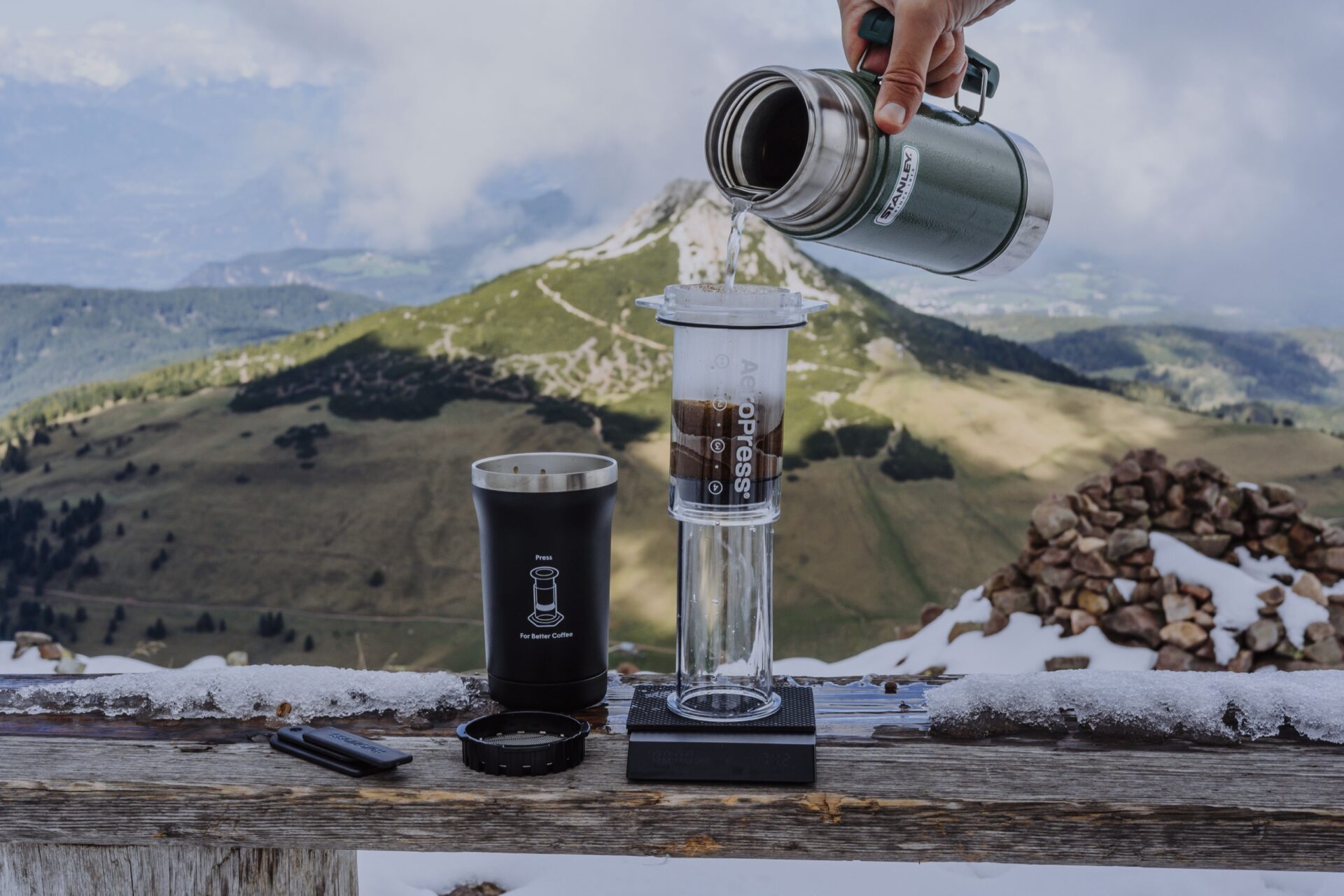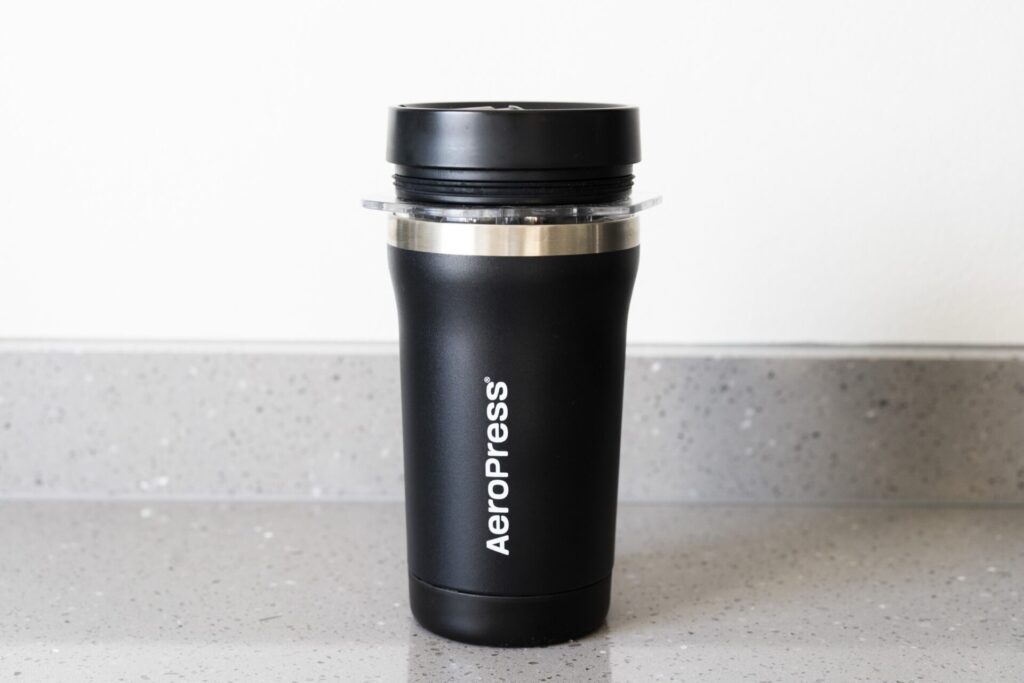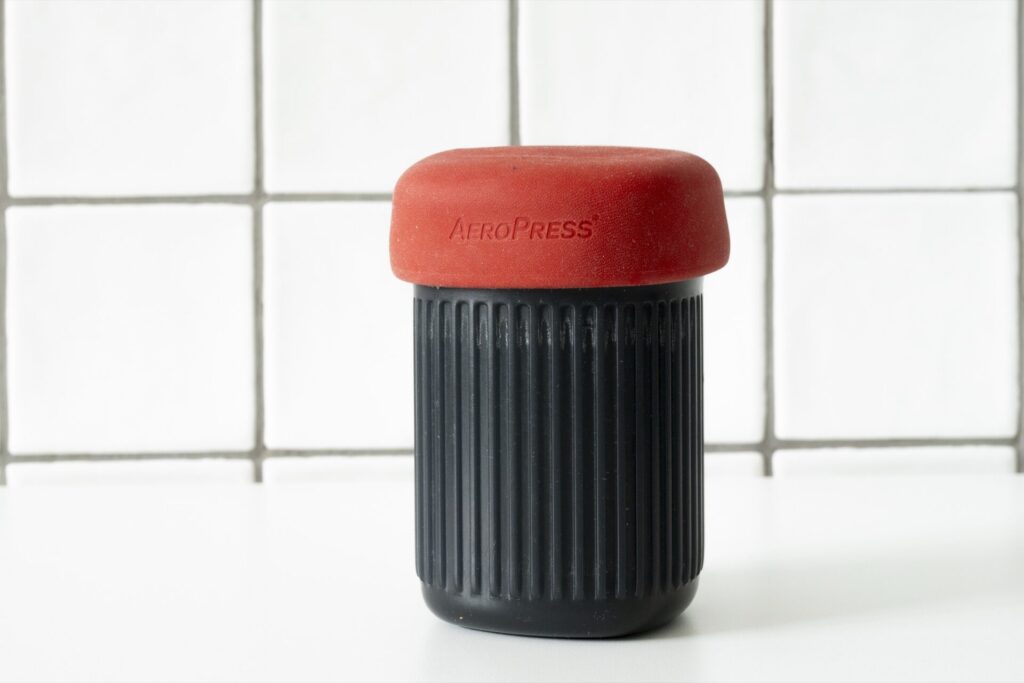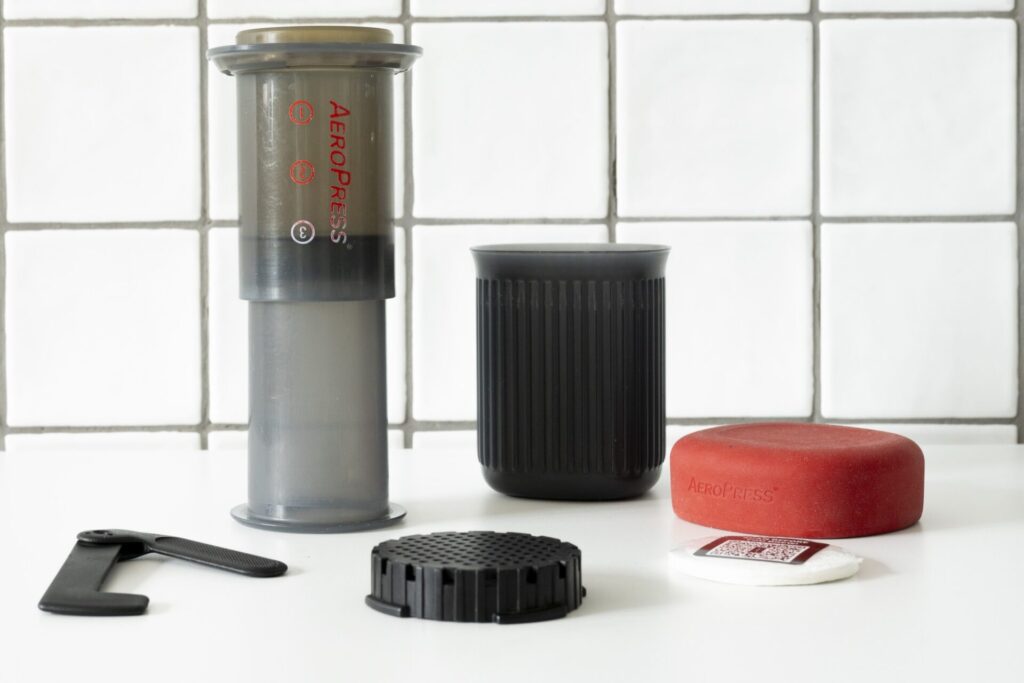
AeroPress Go vs AeroPress Go Plus Comparison:
the Ultimate Review
This comparison is for anyone trying to decide whether the AeroPress Go Plus is worth upgrading from the original AeroPress Go or which of the two portable brewers to buy. I didn’t drag any rival brewers into this comparison on purpose. The focus here is just these two AeroPress travel options. Before we dive into the detailed comparison, let’s quickly introduce the AeroPress Go Plus, recap what the original AeroPress Go is, and then we’ll look at how the Go Plus stacks up in terms of design, performance, and features.
This article contains affiliate links to Amazon. As an Amazon Associate I earn from qualifying purchases.
Introduction: the New AeroPress Go Plus
In mid-2024, AeroPress launched a new travel coffee maker: the AeroPress Go Plus. It’s essentially an upgrade of the popular AeroPress Go from 2019. The Go Plus is marketed as a complete travel coffee system, so think of it as if the AeroPress Go did a survey, listened to everyone’s complaints, and came back as an improved version of itself. You still get AeroPress’ familiar 3-in-1 brewing style but in a crystal-clear brewing chamber that packs neatly into a travel mug. Upgrades include a larger brew capacity, the aformentioned transparent chamber, and a redesigned travel tumbler. It is aimed at coffee drinkers who liked the original Go, but also had some pretty specific feedback about what could be better.
A Quick Recap: the Original AeroPress Go
The AeroPress Go launched in 2019. The inventors basically took the classic AeroPress and shrunk the whole setup into a portable kit. That meant a smaller brewing chamber (enough for about 8 oz of coffee), a compact plastic mug that doubles as a carrying case, and travel-friendly accessories like a folding stirrer and a scoop.
The Go quickly became a Go-to for travelers and campers because it’s lightweight, self-contained, and still brews that same coffee AeroPress is known for. But it wasn’t perfect. Here are a few downsides:
The brewing capacity is significantly smaller than the original full-size AeroPress.
The included mug is a single-wall plastic cup with a rubbery cover, not an insulated, leak-proof travel lid.
Overall, the kit didn’t feel premium in terms of build.
Fast-forward to 2024 and the AeroPress Go Plus is AeroPress’ answer to those criticisms. In the sections below, we’ll take a proper deep dive into how the AeroPress Go Plus compares to the original AeroPress Go. We’ll look at where they’re the same (spoiler: they are very similar at their core) and where the Go Plus pulls ahead in design, performance, and overall user experience. By the end, you should have a clear sense of what’s actually new in the AeroPress Go Plus and whether those upgrades make a noticeable difference in daily use.
What AeroPress Go and AeroPress Go Plus Have in Common
Even with the updates, the AeroPress Go Plus and the original AeroPress Go share a lot of the same DNA. They’re both portable, manual coffee presses designed to make a single cup of coffee or an espresso-style concentrate, and to do it quickly. Here are the main similarities:
Brewing Method & Taste
Both brewers use the exact same method: the classic AeroPress immersion brew followed by gentle air pressure pushing the coffee through a paper micro-filter. The result? The same flavor profile from both. You can expect smooth, full-bodied coffee. The underlying 3-in-1 brew technology hasn’t changed at all. Both devices can brew:
Standard American-style coffee
Espresso-style concentrate (which you can dilute)
Cold brew, using slow-steep style recipes
So if you brew the same recipe with the same grind in a Go and a Go Plus, the coffee will taste the same. AeroPress didn’t reinvent how the coffee is brewed, rather they refined the overall format and packaging of the system. Check out my brew guide with champion recipes for the AeroPress Go.
Portability & All-in-One Design
A big selling point of the AeroPress Go series is that everything fits inside its own mug, so you can just toss it into your bag. Both the Go and the Go Plus are self-contained travel kits. Each kit packs in the brewer (chamber + plunger), filter cap, paper filters, stirrer, and scoop. The latter I could personally do without as I never use it. All of this can be stored inside the included mug. It keeps everything neatly packed and is a huge part of why both models are so popular for travel and camping. In both cases, you don’t need an extra case or bag. The mug is the case.
Quick Brew Time
In terms of speed, nothing has changed. Both models brew a cup of coffee in roughly 1–2 minutes. The workflow is the same: add coffee and hot water, stir, then press. AeroPress promotes both devices as extremely fast brewers and I can attest that the Go and the Go Plus perform equally well on speed.
Paper Micro-Filters & Compatibility
The AeroPress Go and Go Plus both use the same paper micro-filters as the original AeroPress. The filter diameter and the filter cap design are unchanged. There is no special filters needed for the Go Plus. The standard AeroPress paper filters work in both. Most third-party accessories that fit the original (like metal reusable filters or the AeroPress Flow Control Filter Cap) will fit both the Go and the Go Plus. The brew chamber circumference is effectively the same standard AeroPress size on both models. That’s good news if you’ve already invested in accessories for an older AeroPress. You can simply carry them over.
Cleaning and Maintenance
Here, too, both are basically identical. The Go and Go Plus are famously easy to clean. Most of the time, a quick rinse of the chamber and plunger does the job. The silicone plunger seal can be removed on both models for the occasional deep clean or replacement. Long-time AeroPress users already know how low-maintenance these brewers are, and the Go Plus doesn’t change that. You’ll still spend way more time drinking coffee than cleaning up.
Soooo… fundamentally not much has changed, but the Go Plus tackles some of the original Go’s weak spots and adds a few handy features. Let’s unpack those next.


Key Differences Between the AeroPress Go and Go Plus
AeroPress has openly said that two of their main goals with the Go Plus were to let people brew more coffee in one go and give them a better travel cup to drink from. Here’s how the two models differ, point by point.
Brewing Capacity
Both brewers are designed to make roughly 1 cup of coffee per pressing. On the chamber markings it looks like this:
The original Go is marked 1 to 3
The Go Plus is marked 1 to 4
In practice, both are single-brew devices. If you’re making coffee for several people, you’ll be doing multiple presses with either model. The precise volume difference is notable. The AeroPress Go has a slightly smaller chamber, up to about 8 oz (236 ml). The AeroPress Go Plus has a bigger brewing chamber. It can brew up to about 10 oz (295 ml) of coffee. In practical terms, that 20–25% increase in capacity means you can press a larger cup in one go with the Go Plus. Plenty of users who avoided the original Go specifically because of its reduced volume have welcomed this change. But in any case, neither are multi-cup.
Core Materials
Both models use food-safe, BPA-free plastic for the main brewing components: chamber and plunger.
The AeroPress Go uses polypropylene: a sturdy, opaque, BPA-free plastic
The AeroPress Go Plus uses Tritan™ copolyester: a shatter-resistant, BPA-free, clear plastic
The seal on the plunger is silicone on both devices. So while the specific plastic differs (opaque vs clear), both are durable and designed to handle high brewing temperatures safely.
In other words: Both are robust enough to be thrown into a backpack, both are made in the USA to AeroPress’ quality standards and there’s no meaningful difference in basic safety or durability of the brewing parts themselves. If you’ve trusted a Go in your bag, you can expect the Go Plus to survive the same treatment. If anything, Tritan can feel even more solid.
Branding, Design and Aesthetics
The AeroPress Go Plus is the first product to showcase AeroPress’ refreshed branding. That includes the tagline Press for Better Coffee printed on the tumbler and a little AeroPress-shaped icon on the lid slider. It’s cosmetic, but it makes the Go Plus feel more modern and polished compared to the very minimal branding on the original Go (which basically just had the AeroPress logo molded into the chamber).
A key visual difference is the clear vs opaque brewing chamber. The AeroPress Go has a solid gray, semi-opaque chamber and plunger while the AeroPress Go Plus has a transparent brewing chamber and plunger. The Go Plus’s clear design is actually borrowed from the clear AeroPress model that launched in 2023. What’s neat is that you can watch and photograph the entire brewing process, from the grounds saturating, coffee steeping, and the press-out. It’s simply more satisfying and can help you keep an eye on extraction (for example, checking that all grounds are fully wet). The clear plastic is also UV-resistant to help prevent yellowing over time.
The travel mug is where things really diverge. The original Go uses a simpler single-wall 8 oz plastic cup and a flexible rubbery cover for storage meant to hold everything together in transit. As it’s no true drinking lid you had to take it off to sip and it isn’t leak-proof. It’s basically like any ordinary plastic cup that loses heat quickly.
The AeroPress Go Plus comes with a completely redesigned travel mug. It’s a 16 oz (473 ml) double-wall insulated stainless steel tumbler designed to keep drinks hot (or cold) for hours. While it’s not quite on par with the absolute best thermos, it’s miles ahead of an open plastic cup. Moreover, it is leak-resistant and has a magnetically latched slider lid that opens to drink and closes to prevent spills. This is a massive difference in day-to-day usability. If you sip slowly or want your drink to stay warm while you move around, the Go Plus tumbler is way more practical than the Go cup.
In practice, this is a major quality-of-life upgrade: brew directly into the insulated mug, slap the lid on, and walk out the door. No more brewing into the Go’s plastic cup and then pouring into a separate insulated mug, which is what I used to do previously. Another plus, the new mug has a tapered shape to fit car cup holders.
If you like some aesthetic color choice, the Go Plus is also more interesting. The tumbler launched in black, cream, and pink. The AeroPress Go on the other hand is a bit more limited in terms of colors. It comes as a dark gray brewer with red logo (or grey-white logo for newer versions) and a red lid. To add a bit of personal touch you can buy an AeroPress Go Decorative Lid to replace the original one.
You cannot fit an older AeroPress (Original, Go, or Clear) into the Go Plus tumbler for storage though. The mug is designed specifically for the Go Plus.
Integrated Filter Storage
The Go Plus tumbler also hides a clever extra that was not part of the original Go: a built-in filter holder. The new tumbler has a compartment in its base that can store around 25 paper filters. It comes in the form of a cap on the bottom of the steel mug that acts as a filter stash. On the AeroPress Go, you got a small separate plastic case for filters (usually holding about 20), which you had to remember to pack inside the mug or somewhere else in your bag. I barely used it because it kept opening up and losing the filters. Having the filter storage integrated into the mug itself means one less loose item. I also store my AeroPress metal filter in it, which fits perfectly.
Packing & Assembly
Packing the Go Plus is a little different from packing the original Go. Original Go: You invert the brewer into the plastic mug and then use the red-orange silicone lid to stretch over the top and hold everything together. With the Go Plus, you nest the brewer parts inside the insulated tumbler and rely on a combination of the lid, the chamber, and the tumbler keep everything secure. The external gasket on the chamber helps create a snug friction fit. The Go Plus doesn’t use a silicone lid at all. Instead, everything in the Go Plus clicks together more cleanly and feels like a unified object when packed. I was curious whether the magnet and friction fit would be enough for rough travel, but in practice it seems to work well so far. No more loose bits wrapped in a rubber cap.
Accessory Changes
Both kits ship with a scoop and a stirrer, but AeroPress slightly tweaked the designs for the Go Plus, The original Go had a folding paddle stirrer that snapped in half for storage. The Go Plus includes a customized travel stirrer with a slightly different shape (more compact and better suited to the new tumbler). The scoop is also slightly redesigned, mostly to fit better in the new packing layout.
Functionally, nothing dramatic has changed here. A scoop is still a scoop, and a stirrer is still a stirrer. One thing that’s stayed consistent: The funnel that once came with the original AeroPress is not included with the AeroPress Go or the Go Plus. AeroPress dropped it from travel kits because you’re meant to brew into the included wide-mouthed cup. If you want a funnel for narrow containers, you’ll need to source one separately.
AeroPress Go Plus Drawbacks: What You Should Know Before Buying
A Note on the Lid’s and Filter Holder’s Quirks
The Go Plus lid isn’t perfect. If you snap the slider closed too fast, it can cause splattering. AeroPress actually addressed this in their FAQ and recommends closing the slider slowly and gently to avoid spills. Another drawback I noticed is that water will creep into the filter holder when giving the mug a rinse. It would’ve been much better if the filter holder had some kind of insulation. To me it happened a few times, that I forget to remove the paper filter and they are soaked after I gave the tumbler a rinse.
Size & Weight: Portability Trade-offs
With more capacity and a stainless steel insulated tumbler, the AeroPress Go Plus is inevitably larger and heavier than the AeroPress Go. This is the key trade-off in my opinion. The Go is around 4.5 in or 11.4 cm tall packed. The Go Plus is about 7.3 in or 18.5 cm tall when everything is nested inside the tumbler. The diameter is similar: Go Plus tumbler is tapered and roughly 3.7–4.2 in at the top. The Go mug is around 3.6 in at the top. So the Go Plus is taller and more bottle-like. It still packs easily into most bags, but if you’re used to the Go kit, the Plus will stick out further from side pockets. The upside is that it fits in car cup holders much better, and that’s deliberate. The short, wide Go mug often didn’t work well in standard cup holders. There is also a considerable difference in weight: The Go is about 11.4 oz or 323 g packed. The Go Plus is roughly 1 lb 4 oz or 566 g packed. That makes the Go Plus roughly 75% heavier. Most of that weight is from the double-wall stainless steel tumbler. For most travelers, around 0.56 kg is still perfectly reasonable, especially considering this replaces both a brewer and a separate travel mug. If you’re ultra-weight-conscious, like on a serious backpacking trip, the original Go still wins.
Price Difference
The AeroPress Go Plus is more expensive than the AeroPress Go. AeroPress markets the Go Plus as a premium all-in-one system, essentially comparable to buying a high-quality travel mug plus a full-size AeroPress. So what are you actually paying extra for?
Bigger brew capacity
A significantly better, insulated travel mug
Built-in filter storage and other convenience features
If you don’t already own an AeroPress Go and you value these extras, the Go Plus might make sense. But if you already have a Go, spending much more just to get a nicer mug and a bit more capacity will feel like a stretch to some. AeroPress still sells the original Go, so the more affordable option remains. The Plus is very much the premium choice for people who want the complete travel setup in one package. On the bright side, like the Go, the Go Plus typically comes with a generous pack of paper filters (around 100), so you’re not forced to immediately buy extras.

Conclusion – Which AeroPress Go Should You Choose?
Both the AeroPress Go and AeroPress Go Plus are genuinely excellent travel coffee makers, just aimed at slightly different priorities.
In short: The AeroPress Go Plus is…
- best if you want a genuinely good travel mug included
- if those extra couple of ounces of volume matter to you
- or if you like the idea of brewing for yourself (and maybe a partner) in two quick presses instead of three or four
- It’s also more modern and arguably more gift-able.
The AeroPress Go (original) remains a fantastic option if…
- you’re on a tighter budget
- weight and compactness matter more than insulation
- you don’t mind (or even prefer) the simple plastic cup
It also has a long track record and crucially, it brews the same quality coffee.
Performance-wise, neither will disappoint you. The real differences are about user experience: how you brew, where you’re brewing, and how you carry your coffee afterward. In a nutshell, the AeroPress Go Plus is the AeroPress Go evolved: bigger brews, better cup, clearer view, higher price.
Either way, it’s a good time to be an AeroPress fan. You can pick the model that fits your style, your budget, and your travel habits. Here’s to many excellent coffees with whichever AeroPress you decide to GO with. Happy pressing!





